Why, good morning! And a happy Friday to you!
Oh, golly! It’s That Dreadful Weekend. That One Dreadful Weekend of the Year that rankles me to the core of my being!
You know what weekend it is, don’t you?
Daylight Savings Time goes into effect.
Woe is me! Why do we do it?!
To get you through this abhorrent, nefarious, detestable, and downright dastardly custom of changing to Daylight Savings Time, I want to tell you about a book that makes me happy through and through. I think it might make you happy, too!
The book is called Colour Confident Stitching by Karen Barbé. It’s…. it’s good. In fact, it’s Really Good.
If you have ever struggled with choosing colors for an embroidery project, this book is for you! I’ll tell you about the book and along the way, I’ll make some brief comparisons with Colour Confidence in Embroidery by Trish Burr, which I reviewed here, for those of you who already have that book, or are deciding between the two books.
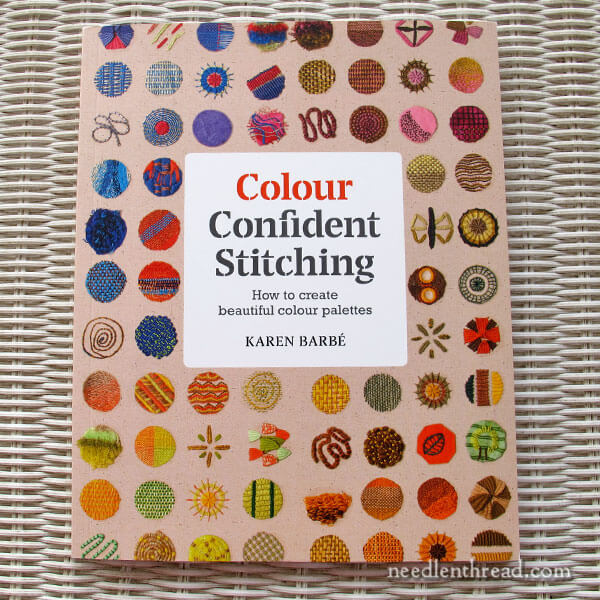
One of the questions that I tackle in my inbox on almost a daily basis is this, or a close variation thereof:
I want to embroider this design. Can you plan it out for me? Can you tell me what stitches, threads, colors, color numbers, techniques to use?
Unfortunately, I can’t usually answer these specific questions for you. To plan out an embroidery project from design to finish – stitches, colors, threads, materials, and everything that goes along with an embroidery project – is a huge job. It takes me weeks to plan a project, and then, once I start stitching it, there are always changes to makes, solutions and alternatives to find for things that don’t work the way I’d hoped. Even when I’m all afire to get the project finished, it can take a month or more before reaching a satisfactory conclusion.
Your best bet, if you want to plan out your own projects, is to arm yourself with good instructional help. A good stitch dictionary and a good book on color can get you through the planning stages.
Colour Confident Stitching is just the type of book on color that will help you plan projects. It will help you understand colors, how they work together, how to select them, and how to consider the whole project with the colors you’ve selected.
The book is primarily a book on color theory and grouping and choosing colors. That said, it’s not a complicated technical book on the scientific side of color theory. It’s a very practical book, it’s easy to understand, easy to read, and eye-opening.
Although there are some stitch instructions and some very basic projects at the end of the book, they’re not the reason to invest in this particular book. In fact, the last section of the book on stitching is rather meh. If you already embroider, you may find this part of the book somewhat underwhelming.
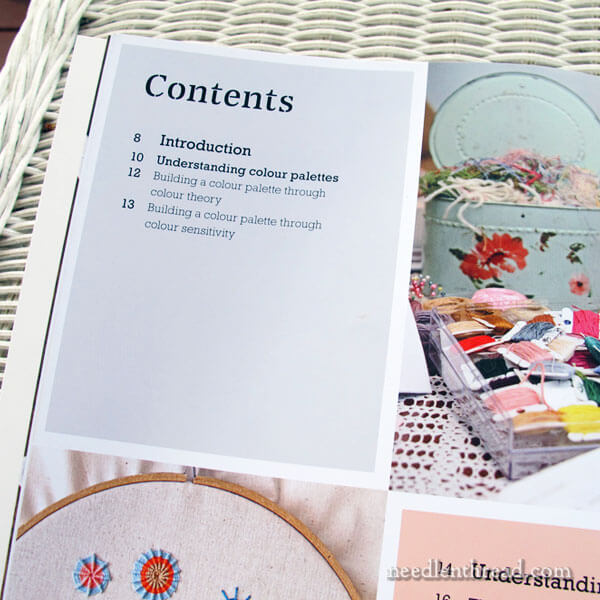
The book is divided into three main parts after the introduction.
In the introduction, you’ll find an overview on understanding color palettes. The author takes two approaches in the book: using color theory to build a color palette, and using color sensitivity to build a color palette.
Essentially, there’s the scientific theory of color, and then there’s our own instinctive approach to color. The author presents both approaches in the book. The latter is a little more advanced and requires a certain “training” of the eye help perceive and work with arrangements of exquisite colors.
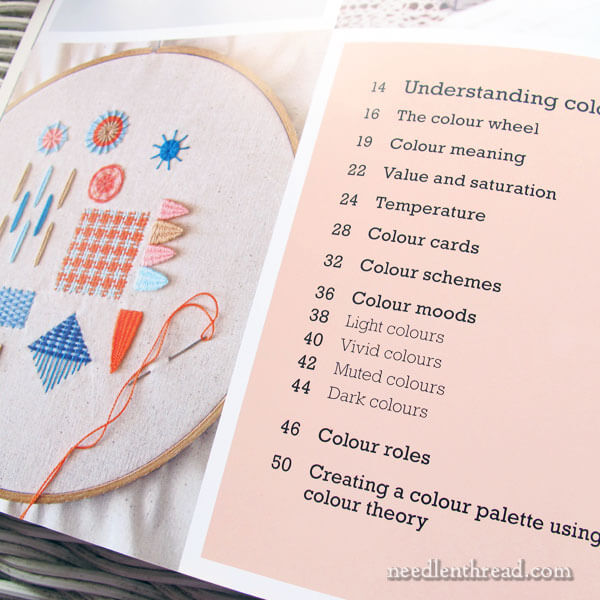
The first part of the book deals with understanding color.
This is where the theory of color unfolds – the color wheel, the meanings we associate with colors, values and saturation, temperature. The author talks about creating color schemes and color cards. She also focuses on moods that can be created with color, color roles, and how to create a color palette using color theory.
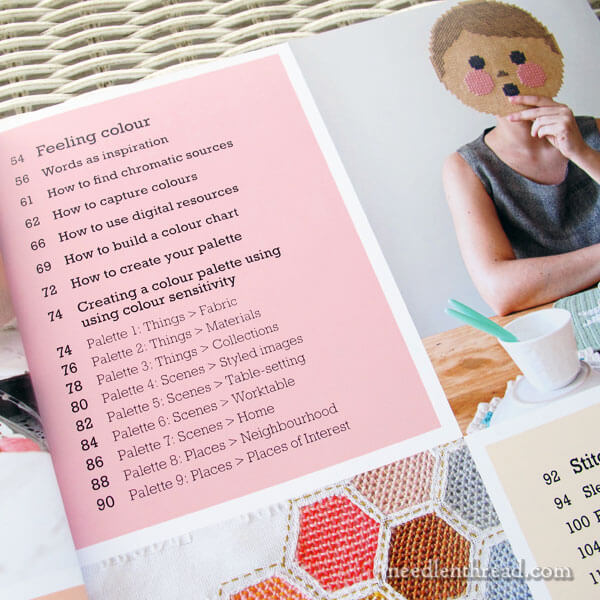
The second section of the book is on feeling color, or color sensitivity. It focuses on how we “capture” color through our own personal experiences.
Barbé shows us how we can train our eyes (on the physical side of things) to “collect” together color combinations that are pleasing to us.
But she also approaches the notion of how the individual’s soul works with color and gathers ideas and inspiration that help form color groupings.
I know this might sound a little weird, so I’ll give you an example of what I mean, using part of the book.
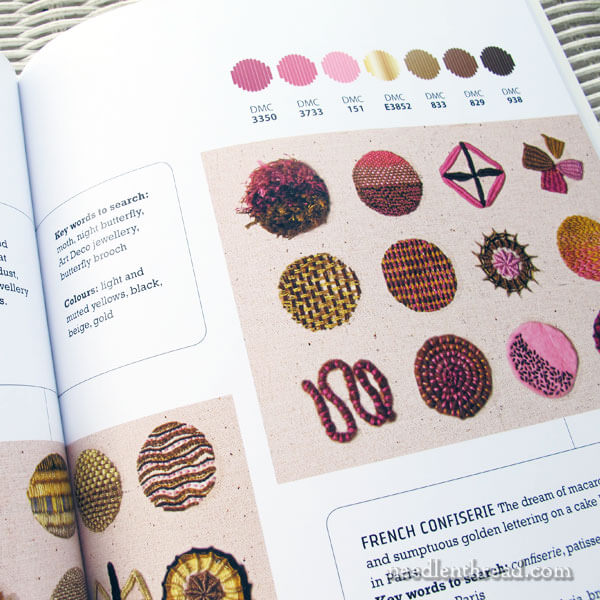
Words, obviously, have meaning. And, while we can define very precisely what we mean when we say things, how we perceive and internalize a concept that’s imparted through words depends a lot on our experiences.
So, for example, in the photo above, Barbé uses a term – French Confiserie – which just means a French confectionary, or a place where you get sweets or pastries.
If you’ve experienced French pastries, hearing “French confectionary” is going to drum up certain notions of color in your mind’s eye. And you can create a color palette that imparts that notion.
Another example. Aurora Borealis. The Northern Lights. The term drums up certain colors in your mind’s eye. How can you capture those colors and turn them into a color palette?
The author tells you. She gives you clear directions on how to train your eye – and your mind’s eye – to capture color, to feel your way through color selections, and to turn those color selections into palettes that work, not just for you as an individual, but that work for anyone who views your embroidery.
I’ll give you another example off the top of my head, that’s not in the book.
Peacock.
You can take the concept imparted by peacock and turn it into a color palette, using the author’s suggestions and instructions on working with color.
This second section of the book is a very interesting approach to color. While it’s an instinctive thing – we might do it anyway, without realizing what we’re doing – the author shows us how to turn our instinctive approach to color into concrete procedures that result in good color combinations that work together.
So while there’s a bit of theory and a bit of instinctive, perceptive work going on, she supplies us with practical methods to get to the end result – a good color palette for an embroidery project.
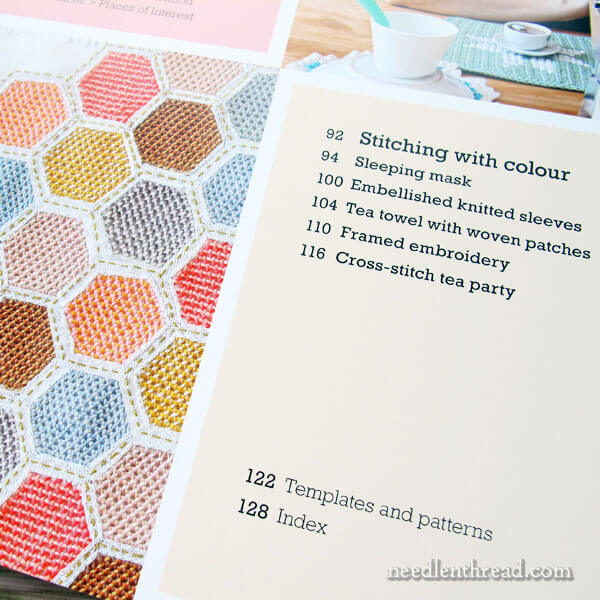
The final section of the book is on stitching with color. This is the project section.
I’m not particularly wowed with the projects or the instructions, although they are, in a way, cute or interesting. They’re just not the type of embroidery I’d normally undertake. If I had to draw a distinction – and this is in no way meant to sound snobby – the projects here are more “embroidery craft” than “embroidery art.”
This is one place where Trish Burr’s book, Colour Confidence with Embroidery, shines in comparison. The projects in Trish’s book are pretty amazing!
But if I were weighing the information on color and working with color between the two books, I’d say Karen Barbé’s book is much deeper and much more thorough on the whole color question.
So, if you were choosing between the two books, I think it would boil down to whether or not you’re looking primarily for a project book or primarily for an instructional book on color.
If you’re looking for a project book with amazing projects, then go with Trish Burr. If you’re looking to gain deep insight and thorough instruction on choosing color and working with color, then go with Karen Barbé’s book.
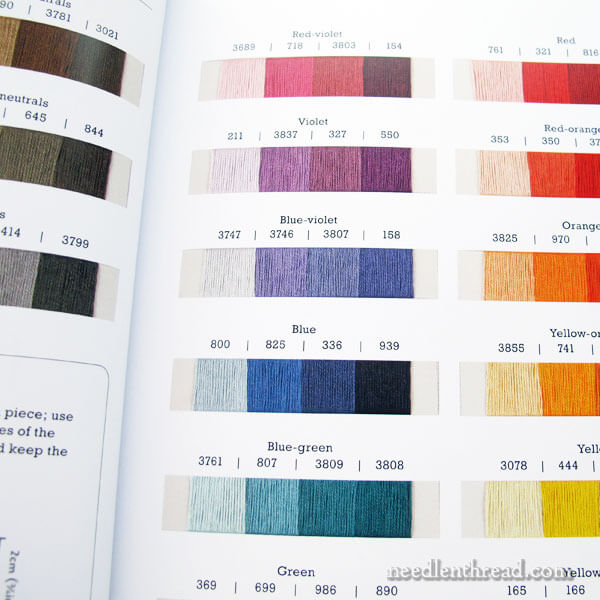
Highlighting a couple points that I really like about Colour Confident Stitching, I especially like the section on creating color palettes using color theory.
The author shows you how to build a color palette of several colors, using color theory, and she demonstrates how the palettes work out in actual thread. (She uses DMC thread colors throughout the book, since they are pretty universal.)
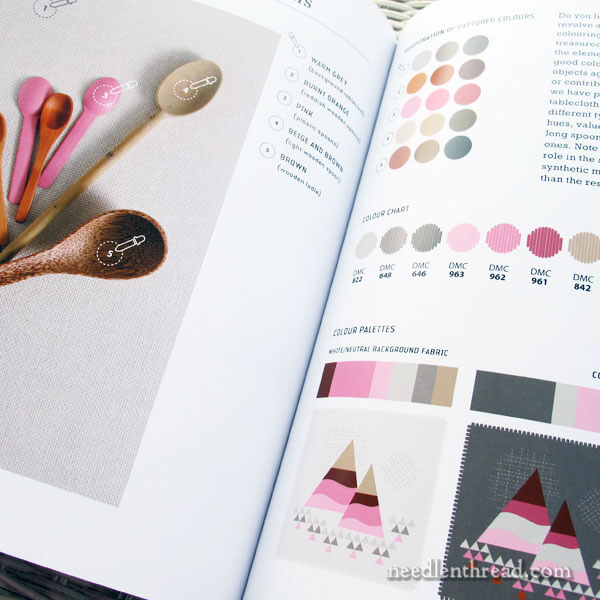
I like how she shows us how to abstract colors from images to create a color palette, and then how to make that color palette work on three different “degrees” of background color. This is extremely helpful, because we don’t always stitch on white!
The author also instructs on abstracting color from digital images, to create color palettes from digital photos that we find pleasing, color-wise. Good stuff!
Pros and Cons
The pros:
1. Very thorough, accessible, and practical instruction on choosing and using colors in embroidery. If color theory has ever baffled you, this book will clear you up!
2. The examples of palettes and colors throughout the book are also given in DMC values, so if you see color schemes that you like, you know which thread colors to choose!
The cons:
If you’re wanting actual embroidery instruction and projects, this is not the book’s strongest point.
In a Nutshell
If you struggle with color in embroidery, you will find clarity in this book! It’s excellent. I strongly recommend it if you want to get into designing your own projects.
Where to Find It
You can find Colour Confident Stitching through the following book affiliates:
In the US, Colour Confident Stitching is available for pre-order here, through Amazon. It is due to be released in the US in June.
Worldwide with free shipping, you’ll find Colour Confident Stitching available here through Book Depository now.







This books has been in my shopping cart for a few weeks. I think it’s time to check out my cart 😉 Thanks for the review.
Is it safe to assume these colour lessons would apply to paints, beading etc?
Yes, I think so! While the color numbers accompanying the swatches presented in the book are all DMC, you can always match paints and beads and whatnot to the color swatches that you like. It’s more about picking color palettes for anything, really, but in terms of color numbers for specifically embroidery related stuff, the colors are matched up with DMC thread numbers.
This is a really interesting addition to the embroidery bookshelf and not like anything else I own. Thanks for the review Mary, I will be checking this title out. I can completely relate to not feeling confident choosing colours (although it feels like it ought to be the easiest thing in the world!) I am used to working other peoples designs and all that work has been done for me. A blank piece of cloth with a box full of threads and a carte blanche has me feeling both excited and overwhelmed in equal parts! I could see this being really helpful as I tentatively try working my own designs. Thank you for the lead. 🙂
Thanks Mary, I ordered it instantly. Ann
Dear Mary
This looks like a very useful book to have for helping with thread colour combinations, I have Trish Burr’s Colour Confidence in Embroidery, Needle Painting Embroidery both are excellent books and very helpful in combining thread colours when starting a project. Equally Karen Barbe book would also be useful on looking at thread colours from a different perspective. I like your point on how to create colour palettes using colour theory that sounds really interesting and unusual. I shall put this on my wish list and try and persuade present buying people to acquire this for for me, you never know I might be lucky. Thanks for sharing your review on Karen Barbe book with us and for your useful and valid points on the book. I do hope you have a great weekend.
Regards Anita Simmance
Oh Mary, thank you, thank you for featuring this book–exactly what I need!
I searched for more information about the author and found out she is from Chile (living in Santiago). And she’s writing in her blog about the book. Maybe you could put the link to her page into your text?
I was curious which approach in colour-interpretation she is using. In different cultures, religions, countries and even times, certrain colours had diffrent meanings. Did she use the western interpretation from today?
Thank you for this blogentry, I will put this book on my list.
Hiss, spit, Daylight Savings Time. I hate it. It saves me nothing. So until we return to standard time, I’m tired. Phooey on DST.
Color? How wonderful. I must admit there are certain colors I rarely stitch with, pink. All shades of pink. The one I mostly stitch with Grey, Black, Green, Blue…..
I just can’t see me using the colors of a doughnut shop on anything. I have to wear blinders to go by a bakery as it is. Just say no to chocolate sprinkles….especially French Patisserie. Now, I’ll be thinking about croissants, bonbons, truffles all weekend. Couldn’t you have chosen the Northern Lights as an example?
DST and CSS (Chocolate Stress Syndrome). What a way to start the weekend.
Happy Friday to you too. Nice book review!
LOL! Sorry, Holly! Yeah, the bakery thing! I’m with you! CSS – Chocolate Stress Syndrome. Funny. Sure sounds better than Cascading Style Sheets.
I only ever stitch with pink when it’s as an accent to something else. But I did start a project last month that was primarily pink, trying to play up with a kind of Valentiney / springy sort of theme. About two hours into stitching, I really disliked it. Pink is something I have to take in small doses, methinks.
DST completely befuddles me. I understand why it initially came about, with the idea of conserving fuel consumption for lighting and whatnot during the world wars, but I don’t understand its persistent use now. Does it really make a difference in economizing energy usage? I somehow doubt it. I think I like the 1940’s term – it was called “War Time” – because it literally puts me in that mood! Incidentally, the first place it was historically used, if I recall correctly, was Canada. Oh, Canada! Tsk tsk. 🙂 Oh, well! We will live through it. And admittedly, come late spring, I do enjoy the lingering sunlight. I just don’t like the dark mornings! Or hauling my sorry carcass out of bed at 3:45 real time. Grrrrrrrr.
Daylight Savings Time. I don’t like the darker mornings, but oh, do I love the longer evenings. Worth one sleepy day this Sunday to me.
I can deal with dark mornings again for a few weeks, to get more daylight in evenings. What I hatehatehate is winter – walking in to work in the dark and walking out of work in the dark. I don’t think I’d do well farther north.
This book looks interesting, but I’m wondering if the only (not a disparaging “only”) thing it offers is DMC colors, is it worth it when I already have color theory books for quilting, knitting, and I think one on beading. Did I mention I have a book problem that your reviews really don’t help? 🙂
Mary, thanks so much for reviewing this book. I just pre-ordered it on Amazon. It’s EXACTLY what I was looking for. I have many project books, so didn’t need another book of projects, but I want to strike out on my own a bit in the design department, and I while I have several good books on color theory, I’ve used most of them for quilting and home projects and not embroidery specifically. Lately, I’ve been using pictures from nature more than anything. What you shared today from Karen Barbe’s book looks basic, practical, AND beautiful: just what I need. Thanks so much! The only good report on the weekend we lose an hour (who thought up that system anyway? GRRRR!).
Embroiderers aren’t the only ones who struggle with finding the right color combinations for a project. I’ve met many a quilter and knitter who stand in front of a wall of fiber, main fabric or yarn in hand, looking dumbstruck. There are so many choices, and it can be overwhelming.
One thing to keep in mind is contrast. Different colors of the same tonal value might not work in a particular project, whereas they might be perfect for another.
And I really like Jinny Beyer’s approach, which is to follow color theory (for example, use a palette of complimentary or tertiary colors), and then throw in a rogue color that is off just a bit from a main color. Perhaps a poison green tossed in with greys, or a grey added to jewel tones.
There are times, though, when I still don’t know if a color scheme is going to work, and the only thing that helps me see if it will is to stitch a small sample piece before getting into a “real” project and discovering that this yellow is too garish, those blues look just like those greens, etc.
Hi, Mary,
On the topic of planning projects, I love to learn about the mind of the artist as much as their art.
I hope you will do another series on the development an embroidery project, letting us listen in on the multitude of factors that you ponder and weigh–purpose, scope, sketches, materials, colors, stitches… Or perhaps other embroidery artists (hello, fellow readers?) could describe their process.
For example, do people start with how the piece will be used (ex.: framed artwork, table linens, pillows, ecclesiastical vestments, or secular clothing) and the stitching technique that makes sense for the project (ex.: crewel, goldwork, ribbon embroidery, etc)? Or do people tend to know what technique they enjoy, and then figure out how to finish and use the completed stitching?
Then there are the subtler questions, such as defining the purpose and mood of the embroidery, how to develop and combine the design elements, how to choose colors and stitches …. Yikes! It’s a lot to put a project together. No wonder people buy kits, or ask you to do it for them .
How much of the design process is intentional (thinking it out systematically) and how much is discovery (aka, feeling your way through)?
I have enjoyed reading your posts on design and hope we can once again listen in on the creative process that you and/or other artists go through when creating a project, and read reflections on how your process has matured over time.
Beth B
PS Yeah, I know, what I just described is yuuuuge. Bigly.